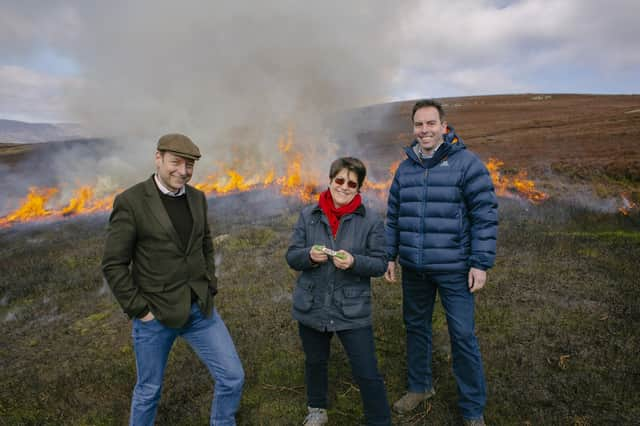MSPs urge Scottish Government to think again over muirburn restrictions


Mr Kerr, who is shadow cabinet secretary for net zero, energy and transport was joined on a recent visit to Glen Lethnot by fellow Conservative MSPs Maurice Golden and Tess White.
The visit, organised by Angus Glens Moorland Group in conjunction with Scottish Land & Estates and BASC Scotland, followed growing concern over the impact of wildfires in Scotland and the implications of the Wildlife Management and Muirburn (Scotland) Bill, currently at Stage 1 in the Scottish Parliament.
Advertisement
Hide AdAdvertisement
Hide AdMr Golden said: “I would urge Scottish Government ministers to come and see for themselves the damage their proposals risk doing to the countryside.
"Everyone acknowledges the increasing risk of wildfires and the devastation these can cause to homes, rural businesses and communities. Yet the Scottish Government’s proposals will limit the options when it comes to land management and averting these fires. It must change its approach now for the sake of rural Scotland and the environment.”
Estates maintain that muirburn plays a vital role in creating firebreaks and reducing the amount of combustible vegetation on moorland, thus reducing the risk of wildfires and limiting their spread when they do occur. Scottish Government proposals, however, would see other methods of vegetation control – such as cutting – prioritised over muirburn on peatland.
Land managers, scientists and firefighters have warned this would not necessarily prevent wildfire, as the cut brash can dry out and can become ideal tinder for wildfire ignition.
Advertisement
Hide AdAdvertisement
Hide AdDuring the visit the MSPs tried their hand at some of Glen Lethnot’s safety equipment including leaf blowers, used to quickly extinguish a burn after the tips of the vegetation have been burnt off. They also saw firsthand the ‘Mars Bar v Muirburn’ experiment, which shows that a chocolate bar placed in the heather does not melt even as the fire burns above it, demonstrating how little impact a properly conducted muirburn has on the ground beneath.
Mr Kerr said: “Wildfires have a devastating effect on our countryside and are extremely damaging to the environment, wildlife and nearby communities. We also have a responsibility to improve the welfare of wildlife wherever possible which is why the Scottish Government’s Wildlife Management and Muirburn (Scotland) Bill must provide an outcome that delivers in the best interests of wildlife, the environment, the rural economy and sustainability of our rural communities.”
Lianne MacLennan, national campaigns manager for Scotland’s Regional Moorland Groups added: “We were delighted to see the interest shown by the MSPs and their understanding of the benefits of prescribed burning. We are concerned that despite all the evidence, the Scottish Government is seeking to restrict muirburn by adding constraints to one of the most important land management tools we have.
“Recently we worked alongside Lantra, NatureScot, the Scottish Gamekeepers’ Association and the Scottish Fire and Rescue Service (SFRS) to launch a new training module for muirburn, in recognition of its important conservation benefits. It is a crucial tool to protect our heather moorland and the landscapes we love.
Advertisement
Hide AdAdvertisement
Hide Ad“If we want to boost biodiversity, we must protect rare species that are specially adapted to moorland habitats. By carefully conducting controlled burns, moorland managers look after these habitats and we can see how important this is for plants, insects, reptiles and birds.”
Glen Lethnot is noted for the beauty of its landscapes and for the many rare birds that nest on its moors. There are good populations of lapwing, curlew, red kite, snipe, red grouse, buzzard, raven and oystercatcher at Glen Lethnot. The sustainable management practices carried out by estate staff, including muirburn, are an important tool in creating the right habitat for these birds to return to nest year after year, in marked contrast to many other parts of the country, where rare bird species are in decline.
BASC Scotland public affairs manager, Peter Clark said: “We are grateful to the MSPs for attending the muirburn demonstration and the Wildlife Management and Muirburn Bill briefing.
“It was important for them to see and hear first-hand from gamekeepers, those directly affected by this legislation, about the challenges the sector will face if the Bill passes. BASC opposes the licensing proposed by this Bill, precisely because it will affect the ability of land managers to effectively protect Scotland’s biodiversity in our uplands.
Advertisement
Hide AdAdvertisement
Hide Ad“Informing MSPs of the economic and environmental benefits of grouse moor management is crucial, as the Bill is taken forward through Parliament. BASC will be working with MSPs and the Rural Affairs Cabinet Secretary to ensure that the Bill does not have detrimental consequences for shooting and conservation.”
Experts including Associate Professor Dr Andreas Heinemeyer of the University of York, Professor Rob Marrs of the University of Liverpool, international wildfire adviser Marc Castellnou and Bruce Farquharson of the SFRS have recently endorsed the practice of muirburn as a means of preventing devastating wildfires and mitigating their spread when they do occur.
Ross Ewing, Director of Moorland at Scottish Land & Estates, said: “While we appreciate the Scottish Government’s recognition that muirburn does have a role to play in wildfire mitigation, the proposals set out in the Wildlife Management and Muirburn (Scotland) Bill are completely counterintuitive.
“It would be illogical, irresponsible and dangerous to prioritise vegetation control methods that are far less effective when it comes to preventing and reducing the risk of wildfire. Cutting vegetation, for example, does reduce the fuel load, but it leaves behind brash which can dry out and become ideal tinder for wildfire ignition. Muirburn, by contrast, leaves no brash behind, minimising risk to the greatest extent.
Advertisement
Hide AdAdvertisement
Hide Ad“We urge the Scottish Government to drop the provision which will limit the extent of muirburn use on peatland, and ultimately curtail our ability to prevent and reduce wildfire risk on our most precious carbon store.”